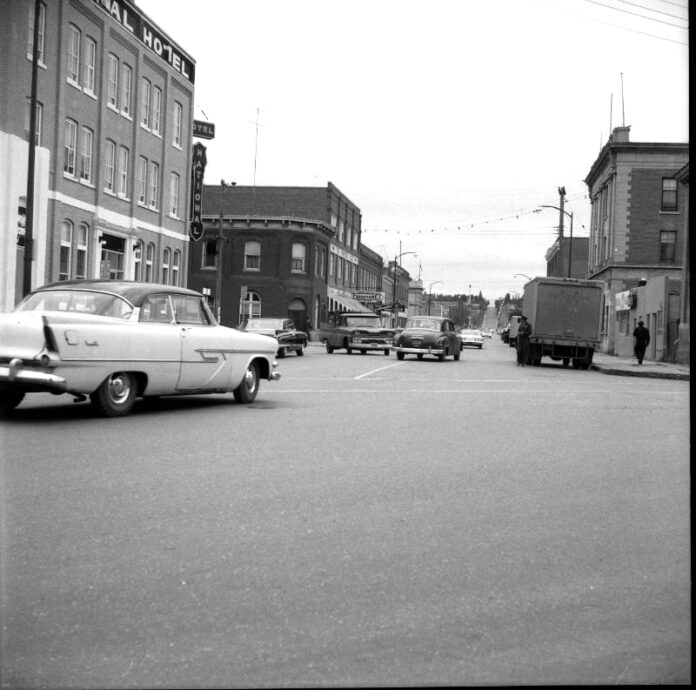by Joan Champ
In the early 1970s, my high school friends and I occasionally “cruised” the one-way-street loop in downtown Prince Albert. We started at the bottom of the viaduct onto one-way Central Avenue, turned left on River Street, and then headed up First Avenue West – at that time also a one-way street, left onto 15th Street, and back onto Central again. This cruise often involved a stop at the A & W drive-in, where carhops would hook trays filled with our orders onto our car windows. The carhops are gone now and Gateway Mall has taken out the one-way street up First Avenue West, but the A & W and the one-way route down Central Avenue still remain.
Like many city residents throughout North America, Prince Albertans are living with the legacy of these one-way streets. As the car culture boomed in the 1950s, one-way streets were introduced as a traffic safety tool. City planners believed they would reduce accident rates by allowing for better traffic signal progression, creating traffic “clusters” with wide gaps between them. This would make it much safer for cross-street traffic, pedestrians, and bicycles to cross major streets.
In Prince Albert, the new one-way street system was introduced at 9:00 a.m. on September 11, 1963. Only Central Avenue and First Avenue West were converted; all other streets and the viaduct remained two-way. One-way signs were uncovered by city crews at the appointed hour. New traffic lights, including walk signals for pedestrians, had been installed. “I would ask all citizens to familiarize themselves with the change,” Mayor Allan Barsky told the Herald. “I feel sure that in due course one-way street driving will become second nature to them.”
On the day of the conversion, city police were on duty to assist drivers in an effort to help prevent all possible accidents. Warnings were given to drivers for any traffic violations for a limited time while motorists became accustomed to the new platn. Parking on Central Avenue was also an adjustment. Drivers had to be reminded that while parking was allowed on both sides of the street, all vehicles had to be facing north.
The day after, the Daily Herald reported that the changeover had gone fairly well. “There were still a number of people, even after all the publicity given to the one-way system,” the Herald stated, “still proceeding along Central Avenue and First Avenue West, the wrong way.” Two accidents – two-car collisions – were reported immediately after the change, one of them occurring less than an hour after the system went into effect.
Speeding was a problem. Without the danger of oncoming traffic, one-way streets can feel like an invitation to hit the gas. “We have noticed some motorists engaging in dangerous practices,” a Herald editorial stated on September 13. “One is a tendency of some motorists to engage in lane-hopping, picking ‘holes’ in one lane or the other, switching lanes without first turning on signals, under the false impression that they are thus saving time.” Mayor Barsky told the newspaper that, while he was “very pleased” with the way the new one-way system was working out, the City “did not intend to allow the streets to become drag strips or speedways.” He cautioned that the new system was designed to provide a faster, more fluid movement of traffic, but this was to be obtained without exceeding the speed limit.
The new one-way streets presented an interesting challenge for the fire department, which was located at the bottom of Central Avenue on River Street where the museum is now. Fire Chief George Slater said the new system was better for the department. He noted that if a fire broke out on Central Avenue, the trucks would have to travel south on Central, against the one-way traffic flow. “This is common practice in other centres,” he said. “In some ways it is even safer than when traffic is going both ways, as all the traffic is facing the on-coming trucks.”
By the beginning of October 1958, the Herald reported that Prince Albertans were getting used to the one-way street pattern. Very few accidents had been reported, however the police chief said there were still a few drivers who absent-mindedly turned the wrong way on either Central Avenue or First Avenue West.
After living away from Prince Albert for several decades, I have to admit that one-way Central Avenue has taken me a bit of getting used to. So far, though, I haven’t caused any accidents.
Thanks to the Bill Smiley Archives for its assistance in preparing this column.
Contact: joanchamp@shaw.ca


